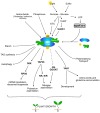The Plant Target of Rapamycin: A Conduc TOR of Nutrition and Metabolism in Photosynthetic Organisms
- PMID: 33138108
- PMCID: PMC7694126
- DOI: 10.3390/genes11111285
The Plant Target of Rapamycin: A Conduc TOR of Nutrition and Metabolism in Photosynthetic Organisms
Abstract
Living organisms possess many mechanisms to sense nutrients and favorable conditions, which allow them to grow and develop. Photosynthetic organisms are very diverse, from green unicellular algae to multicellular flowering plants, but most of them are sessile and thus unable to escape from the biotic and abiotic stresses they experience. The Target of Rapamycin (TOR) signaling pathway is conserved in all eukaryotes and acts as a central regulatory hub between growth and extrinsic factors, such as nutrients or stress. However, relatively little is known about the regulations and roles of this pathway in plants and algae. Although some features of the TOR pathway seem to have been highly conserved throughout evolution, others clearly differ in plants, perhaps reflecting adaptations to different lifestyles and the rewiring of this primordial signaling module to adapt to specific requirements. Indeed, TOR is involved in plant responses to a vast array of signals including nutrients, hormones, light, stresses or pathogens. In this review, we will summarize recent studies that address the regulations of TOR by nutrients in photosynthetic organisms, and the roles of TOR in controlling important metabolic pathways, highlighting similarities and differences with the other eukaryotes.
Keywords: carbon; metabolism; nitrogen; nutrition; photosynthetic organisms; plant; sugars; sulfur; target of rapamycin (TOR).
Conflict of interest statement
The authors declare no conflict of interest.
Figures

References
-
- Dutrochet H. L’Agent Immédiat du Mouvement Vital Chez les Végétaux et Chez les Animaux. Nabu Press; Paris, France: 1826.
Publication types
MeSH terms
Substances
LinkOut - more resources
Full Text Sources

